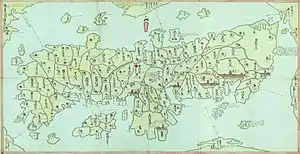Uto Domain
Uto Domain (宇土藩, Uto-han), also known as Udo Domain, was a Japanese domain of the Edo period. It was associated with Higo Province in modern-day Kumamoto Prefecture.[1]
| Uto Domain 宇土藩 | |||||||||
|---|---|---|---|---|---|---|---|---|---|
| Domain of Japan | |||||||||
| 1646–1870 | |||||||||
| Capital | Uto jin'ya | ||||||||
| • Type | Daimyō | ||||||||
| Historical era | Edo period | ||||||||
• Established | 1646 | ||||||||
• Disestablished | 1870 | ||||||||
| |||||||||
| Today part of | Kumamoto Prefecture | ||||||||
In the han system, Uto was a political and economic abstraction based on periodic cadastral surveys and projected agricultural yields.[2] In other words, the domain was defined in terms of kokudaka, not land area.[3] This was different from the feudalism of the West.
History
The domain was headed by a cadet branch of the Hosokawa clan of Kumamoto.[4] The Uto Domain (30,000 koku) was created in Higo Province when Hosokawa Tadaoki abdicated, so that Hosokawa Tatsutaka would have a fief to inherit upon his father's death. However, Tatsutaka died the same year, and rights of inheritance were transferred to his first son Hosokawa Yukitaka (1637-1690), so that he and his young siblings would be not be left impoverished. The child Yukitaka thus became the first lord of the newly created Uto Domain on the death of his father in 1646. He also became head of a cadet branch of the Hosokawa clan.
List of daimyōs
The hereditary daimyōs were head of the clan and head of the domain.
- Hosokawa clan, 1646–1870 (tozama; 30,000 koku)[5]
See also
- List of Han
- Abolition of the han system
References

- "Higo Province" at JapaneseCastleExplorer.com; retrieved 2013-5-28.
- Mass, Jeffrey P. and William B. Hauser. (1987). The Bakufu in Japanese History, p. 150.
- Elison, George and Bardwell L. Smith (1987). Warlords, Artists, & Commoners: Japan in the Sixteenth Century, p. 18.
- Rein, Johannes Justus. (1884). Japan: Travels and Researches Undertaken at the Cost of the Prussian Government, p. 524.
- Papinot, Jacques Edmond Joseph. (1906). Dictionnaire d’histoire et de géographie du Japon; Papinot, (2003). "Hosokawa" at Nobiliare du Japon, p. 12; retrieved 2013-5-28.
- 細川行孝 at Nihon jinmei daijiten; 細川行孝 at Reichsarchiv.jp; retrieved 2013-5-30.
- 細川立禮 at Nihon jinmei daijiten; retrieved 2013-5-30.
External links
- "Uto" at Edo 300 (in Japanese)
- Uto City Digital Museum (in Japanese)